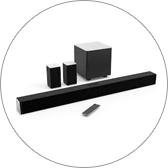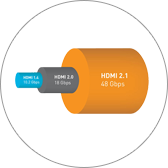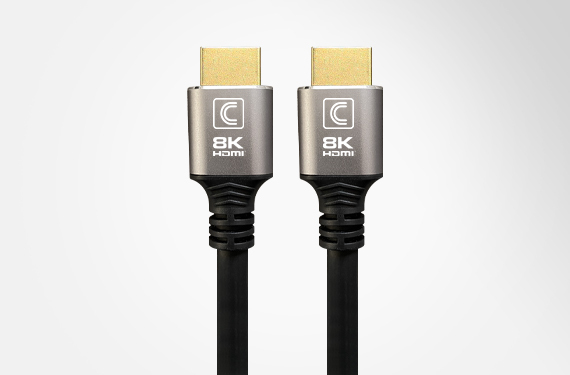
Announced during CES 2017, HDMI 2.1 has some new and exciting features that will enable future support for the ever changing and evolving display and TV markets. One of the most notable features is a huge increase in bandwidth from its 2.0 predecessor; 48Gbps vs 18Gbps. With this increased bandwidth, the new spec will handle 4K @ 60 (4:4:4), 8K @ 60 (4:4:4) and all the way up to 10K @ 100/120. To get this resolution you’ll need a new cable. At this point it is unclear as to the distance limits of 48Gbps, or which technology will be used to get max resolution at distances greater than two meters.
HDMI 2.1 Features
HDMI Versions
HDMI 2.1 Summary
| HDMI Version | 1.0 | 1.1 | 1.2 | 1.3 | 1.4 | 2.0 | 2.1 |
| Date initially releases | 12/9/02 | 5/20/04 | 8/22/05 | 6/22/06 | 6/5/09 | 9/4/13 | Q2 2017 |
| Maximum Bandwidth (Gbps) | 4.95 | 4.95 | 4.95 | 10.2 | 10.2 | 18 | 48 |
| Maximum Resolution | 1600x1200p60 | 1600x1200p60 | 1600x1200p60 | 2048x1536p75 | 4096x2160p24 | 4096x2160p60 | 10K 100/120 |
| Maximum LPCM Audio Channels | 8 Channels | 8 Channels | 8 Channels | 8 Channels | 8 Channels | 32 Channels | 32 Channels |
| Maximum Audio Sampling Rate | 768kHz | 768kHz | 768kHz | 768kHz | 768kHz | 1536kHz | eARC Object Based |
HDMI 2.1 Summary
- 48Gbps vs. 18Gbps in HDMI version 2.0. This will require a new cable beyond the shortest lengths
- Max resolution of 10K @ 100/120 refresh, getting (and 8K @ 60 444) this resolution requires a new cable
- Connectors will not change
- HDMI ver 2.1 is backward compatible with previous versions
- HDMI ver 2.1 covers more of the visible spectrum and color gamut with BT.2020 @ 10, 12, and 16 bits per color component
- HDMI ver 2.1 brings enhanced and finer control of brightness levels throughout the video with Dynamic HDR
- Game Mode Variable Refresh Rate (or, GM VRR) offers perfect 1:1 refresh sync across the frequency range improving motion fluidity, lag reduction, sputter or screen-tear
- eARC introduces object-based audio
- New HDMI 2.1 specs to be released to adopters in Q2 ‘17
HDMI 2.1 Cables from Comprehensive
Comprehensive's 8K HDMI Cables combine cutting edge performance, ultra-flexibility, and unsurpassed reliability. 8K HDMI Cables support 48G, HDR, Deep Color, 21:9 aspect ratio, up to 32 audio channels with eARC, Dolby Atmos and has ethernet built in. All of our 8K HDMI Cables are covered under our exclusive worry-free Lifetime Warranty.
Comprehensive's 8K HDMI Cables combine cutting edge performance, ultra-flexibility, and unsurpassed reliability. 8K HDMI Cables support 48G, HDR, Deep Color, 21:9 aspect ratio, up to 32 audio channels with eARC, Dolby Atmos and has ethernet built in. All of our 8K HDMI Cables are covered under our exclusive worry-free Lifetime Warranty.
HDMI 2.1 FAQs
Q: What is the relationship of HDMI Specification 2.1 to HDMI 2.0b and 1.4b Specifications?
A: HDMI 2.1 Specification supersedes 2.0b and 2.1 continues to make reference to, and rely upon, HDMI 1.4b Specification.
Q: Is HDMI 2.1 Specification backwards compatible with previous versions of the specification?
A: Yes.
Q: Will existing HDMI High Speed cables deliver the HDMI 2.1 features also?
A: While existing HDMI High Speed Cables with Ethernet can deliver some of the new features, the new cable is the best way to connect HDMI 2.1 enabled devices to ensure delivery of all the features.
Q: What are the support resolutions and frame rates for HDMI 2.1?
A: • 4K50/60
• 4K100/120
• 5K50/60
• 5K100/120
• 8K50/60
• 8K100/120
• 10K50/60
• 10K100/120
Q: Is compression used to achieve those resolutions and frame rates?
A: The specification supports both uncompressed and compressed modes. Manufacturers can implement either or both modes. The designations are:
• 4K100A - supports uncompressed mode
• 4K100B - supports compressed mode
• 4K100AB - supports both
• 4K120A - supports uncompressed mode
• 4K120B - supports compressed mode
• 4K120AB - supports both
• 8K50A - supports uncompressed mode
• 8K50B - supports compressed mode
• 8K50AB - supports both
• 8K60A - supports uncompressed mode
• 8K60B - supports compressed mode
Q: HDMI 2.1 Feature Names
A: What are the HDMI 2.1 marketing feature names and their acronyms?
• Ultra High Speed HDMI Cable
• Auto Low Latency Mode (ALLM)
• Enhanced Audio Return Channel (eARC)
• Quick Frame Transport (QFT)
• Quick Media Switching (QMS)
• Variable Refresh Rate (VRR)
The uncompressed/compressed feature name designations include: A= uncompressed, B=compressed, AB=Both
• 4K100A
• 4K100AB
• 4K100B
• 4K120A
• 4K120AB
• 4K120B
• 8K50A
• 8K50AB
• 8K50B
• 8K60A
• 8K60AB
• 8K60B
Q: What color space is supported?
A: HDMI 2.1 Specification supports the latest color spaces including BT.2020 with 10, 12, and 16 bits per color component.
Q: Can this new cable work with existing HDMI devices?
A: The cable is backwards compatible and can be used with existing HDMI devices for the delivery of legacy HDMI features.
Q: Will 8K@60 or 4K@120 require a new cable or cable connector?
A: Yes, a new cable is required.
Q: What connectors will the new cable use?
A: It is compatible with HDMI connectors Types A, C and D.
Q: Is this cable required for delivering HDMI 2.1 Specification features?
A: The cable is the best way to ensure the high-bandwidth dependent features are delivered including the enhanced video and audio performance, and accounting for the new EMI characteristics.
Original Source Material from HDMI.org
For more information on HDMI 2.1, please visit the HDMI.ORG website: https://hdmi.org/spec/hdmi2_1
A: HDMI 2.1 Specification supersedes 2.0b and 2.1 continues to make reference to, and rely upon, HDMI 1.4b Specification.
Q: Is HDMI 2.1 Specification backwards compatible with previous versions of the specification?
A: Yes.
Q: Will existing HDMI High Speed cables deliver the HDMI 2.1 features also?
A: While existing HDMI High Speed Cables with Ethernet can deliver some of the new features, the new cable is the best way to connect HDMI 2.1 enabled devices to ensure delivery of all the features.
Q: What are the support resolutions and frame rates for HDMI 2.1?
A: • 4K50/60
• 4K100/120
• 5K50/60
• 5K100/120
• 8K50/60
• 8K100/120
• 10K50/60
• 10K100/120
Q: Is compression used to achieve those resolutions and frame rates?
A: The specification supports both uncompressed and compressed modes. Manufacturers can implement either or both modes. The designations are:
• 4K100A - supports uncompressed mode
• 4K100B - supports compressed mode
• 4K100AB - supports both
• 4K120A - supports uncompressed mode
• 4K120B - supports compressed mode
• 4K120AB - supports both
• 8K50A - supports uncompressed mode
• 8K50B - supports compressed mode
• 8K50AB - supports both
• 8K60A - supports uncompressed mode
• 8K60B - supports compressed mode
Q: HDMI 2.1 Feature Names
A: What are the HDMI 2.1 marketing feature names and their acronyms?
• Ultra High Speed HDMI Cable
• Auto Low Latency Mode (ALLM)
• Enhanced Audio Return Channel (eARC)
• Quick Frame Transport (QFT)
• Quick Media Switching (QMS)
• Variable Refresh Rate (VRR)
The uncompressed/compressed feature name designations include: A= uncompressed, B=compressed, AB=Both
• 4K100A
• 4K100AB
• 4K100B
• 4K120A
• 4K120AB
• 4K120B
• 8K50A
• 8K50AB
• 8K50B
• 8K60A
• 8K60AB
• 8K60B
Q: What color space is supported?
A: HDMI 2.1 Specification supports the latest color spaces including BT.2020 with 10, 12, and 16 bits per color component.
Q: Can this new cable work with existing HDMI devices?
A: The cable is backwards compatible and can be used with existing HDMI devices for the delivery of legacy HDMI features.
Q: Will 8K@60 or 4K@120 require a new cable or cable connector?
A: Yes, a new cable is required.
Q: What connectors will the new cable use?
A: It is compatible with HDMI connectors Types A, C and D.
Q: Is this cable required for delivering HDMI 2.1 Specification features?
A: The cable is the best way to ensure the high-bandwidth dependent features are delivered including the enhanced video and audio performance, and accounting for the new EMI characteristics.
Original Source Material from HDMI.org
For more information on HDMI 2.1, please visit the HDMI.ORG website: https://hdmi.org/spec/hdmi2_1








